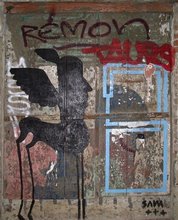While you’ve been working on your presentations and papers I’ve been preoccupying myself with following the media and internet coverage of the killings at Virginia Tech, perusing some of the blogs and websites that have become important for us over the course of the semester, thinking some about where the study of networked public culture fits within the wider framework of cultural studies, and what the impact of the developments we’ve been studying will be on academia in general.
Regarding the Virginia Tech horrors, a couple of things. I don’t know about you, but I found myself immediately upset about NBC’s decision to publish the pictures and video they got from Seung-Hui Cho. I suppose this is marginal to our course focus and is more of a journalism, main-stream media issue, but it seemed to me the decision to publish this material was wrong on a couple of counts. First of all, the network became complicit in the killer’s desire to seek publicity, and secondly they circulated material that had to be traumatic to a large number of people in grief who were struggling to come to terms with mayhem and death in their lives—not just the direct victims and their families but all of us subjected to the slaughter. I suppose they weighed the “newsworthiness” of the material against all this and figured the one trumped the other. It struck me a bit too much as cashing in and not terribly ethical.
Thinking more dispassionately about what this incident tells us about contemporary visual culture, I suppose we have to consider how, on the one hand the communicative technology available to people about to commit a crime like Seung-Hui Cho’s may shape criminal acts in the 21st century, and how the images they produce to frame their crimes will enter public culture in multimedia fashion. It seems as if the committing of a crime may now become a media production and take upon itself all of the aspects of spectacle, but a spectacle produced by the criminal rather than just by the media. This gets back, I suppose, to the whole idea of complicity, that is, what is the extent to which the media becomes complicit in the criminal’s production of spectacle by broadcasting their show? It’s easy to just say, “well, pictures like these will just get out anyway, so why not present them in a controlled and civil way,” but I don’t know. I would have sent the whole package to the police and that would have been that. There’s some connection, it seems to me, between the publication of these pictures and those from the Abu Ghraib prison (at least in terms of the kind of visual cultural event they produced) but I want to take more time to think about that.
Another interesting story coming out of this nightmare can be found in the New York Times article by Noah Cohen about how Wikipedia contributors created “an essential news source” for the events unfolding at Virginia Tech. The “Virginia Tech Massacre” entry at Wikipedia was apparently produced by over 2,000 “reporters” cobbling together an impressive report on what happened. I recommend the article for the perspective it gives on how Wikipedia, or for that matter, the wiki format in general, can be harnessed as a site for open source reporting. This happened to a degree during the Katrina disaster at, of all places, Craigslist, but what the folks at Wikipedia produced is a big leap forward. More and more we may find Wikipedia having value as a source for (flawed, inaccurate?) news as well as for (flawed, inaccurate) historical information.
Tuesday, April 24, 2007
Subscribe to:
Post Comments (Atom)

No comments:
Post a Comment